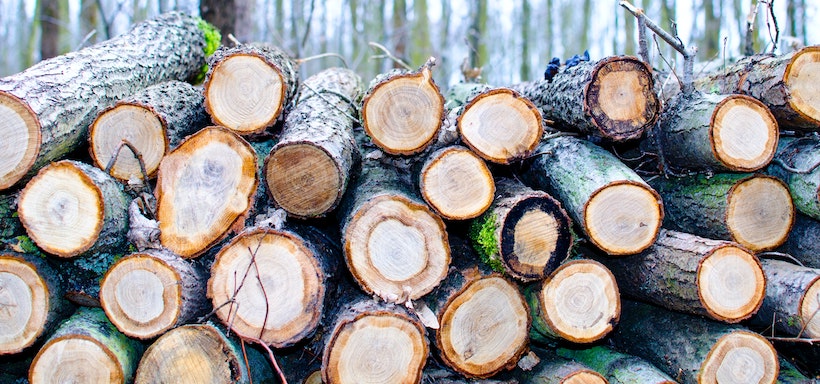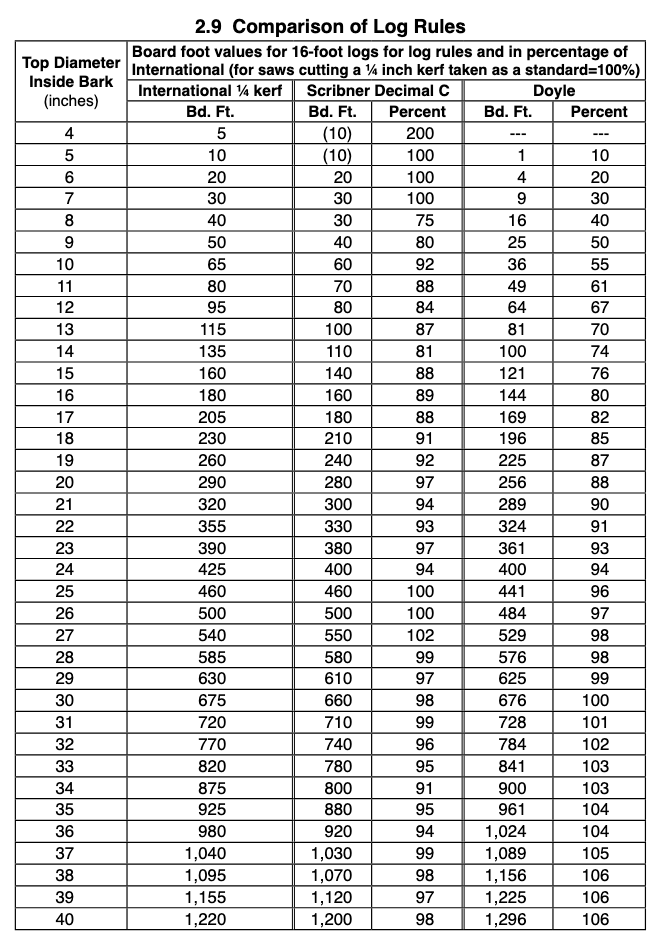On this page is a board foot log rule calculator, which will estimate the board foot yield of a log using the Doyle or Scribner log scale rules, or the International log rule with a 1/4" or 1/8" kerf.
It can also estimate the yield of standing trees using the Wiant and Castaneda adaptations of the Doyle, Scribner, and International 1/4" rule.
(While board feet is the accepted standard in North America, optionally, you can use metric/cubic cm.)
Board Feet Log Rule Calculator
Why Estimate Log Board Feet ?
In order to put a value on a log, you need to estimate the board yield after it comes back from the timber mill. Most commonly in the US and Canada, that's expressed in board feet, the volume equivalent to a 1" x 12" x 12" wide board.
(Other volume measurements sometimes include cords and cubic feet).
That's where the log scaling rules came from – they allow you to estimate the yield of a log, or in some cases, even from a standing tree. Primarily, they are used to value a tree – often after it's already cut, but sometimes while still standing (see the section below).
Estimating the Board Feet in a Log
Once a tree is harvested (or an entire truckload of trees...), we can estimate its yield using other methods, such as complex electronic log volume measurements using lasers, or weight log volume estimates by simply weighing a truck or container when empty and full.

Board-foot Log Rules
While electronics and weighting are well and good, traditional log rules are the most common way to estimate usable lumber.
These rules factor in saw kerf, wastage, knots, and shrinkage – but have their limitations due to different species of trees and lack adjustment for tree taper. They aren't ignorant rules, however – while they produce overrun or underrun (where lumber exceeds or comes short of the rule, respectively), they attempt to factor in wastage and limitations.
Still, log scaling methods are the traditional way to price lumber. In the tool, I've included four – the Doyle Log Rule, Scribner Log Rule, International 1/4" Kerf Log Rule, and International 1/8" Kerf Log Rule.
You can learn the ins and outs of log measurement and scaling in the National Forest Service's National Forest Log Scaling Handbook. There are many more log rules than are in the tool – see an excellent overview here from Frank Freese of the USDA.
Doyle Log Rule
The Doyle Log Rule dates to at least 1837 when Edward Doyle published his initial formula in Rochester, New York. Even though the Doyle Rule is far and away the most popular all time estimate, no known copies of Doyle's 1825 pocket reckoner exist (although it likely contained the rule).
Doyle Log Rule
The Doyle Log Rule approximation is:
Where:
- BF = estimated yield in board feet
- D = Diameter of log in inches, (inside bark) small end of the log
- L = Length of log in feet
Facts About the Doyle Rule
At one time or another, the Doyle rule was the official log scaling method in a number of states. By tradition, it's still even used widely today in many areas as a rough guess of yield.
The main weakness of the Doyle rule is in its allowances for slabs and edgings. (Also see this diagram from Herman Chapman's 1921 Forest Mensuration).
The Doyle Rule gives too much allowance for slabs & edgings in small logs – a pro-buyer characteristic (in small logs, anyway!). For large logs the allowance is too small.
Scribner's rule largely replaced it after its publication in 1846. However, the Doyle rule regained popularity when George W. Fisher bought the rights to Scribner's rule in the mid 1870s and (for whatever reason) published a table of Doyle values in place of Scribner's values in a reissued guide.
Even today, the Doyle rule is the local custom in many areas.
Scribner Log Rule
The Scribner Log Rule was first published in 1846 by J.M Scribner. Scribner based it on estimates off drawings of logs cut using a 1/4" kerf. His original tables ranged from 10' - 24' logs, with 12" - 44" diameter (small end, inside bark).
A number of the tables use the 1942 Bruce and Schumacher Scribner formula estimate (assuming a 16" log):
But a better estimate for the Scribner log rule is McKenzie's 1915 summation for the California State Board of Forestry:
(This is the version in the DQYDJ tool above)
Where:
- BF = estimated yield in board feet
- D = Diameter of log in inches, (inside bark) small end of the log
- L = Length of log in feet
Facts About the Scribner Rule
The Scribner rule was undoubtedly an improvement on Doyle. Scribner (a preacher) even took aim at the log rules in use (read: mostly Doyle) when he first published his rule:
I have spared no pains nor expense to render them perfect; and it is to be hoped that hereafter these will be preferred to the palpably erroneous tables which have hitherto been in use.
J.M. Scribner, on Publication of the Scribner Log Rule Tables
Scribner's rule is reasonably accurate on roughly 16' logs up to a diameter around 28". However, for anything bigger there is generally overrun.
International Log Rules
Judson F. Clark worked for the Province of Ontario in 1900 when he first formulated his International Rule, assuming a 1/8" saw kerf. He first published that rule in 1906.
Seeing as most sawmills of the time couldn't match the performance assumed from his 1/8" rule, Clark published a 1/4" kerf rule in 1917.
1/4" Kerf Log Rule
The International 1/4" kerf log rule as estimated in Grosenbaugh's 1948 Improved cubic volume computation (to convert it from table to formula) is:
1/8" Kerf Log Rule
The International 1/8" kerf log rule as estimated by Grosenbaugh's 1948 Improved cubic volume computation (to convert it from table to formula) is:

Standing Tree Log Scales
Things are a bit more complicated when a tree is still standing – you can't exactly measure the diameter inside the bark of the small end of a log!
Luckily, Harry V. Wiant and Froylan Castaneda adapted three of the log tables for standing trees. Using the diameter of the tree at breast height and assuming a form class 78 tree (a measurement of a tree's taper), they came up with a formula for estimating yield of standing trees using Doyle, Scribner, and the International 1/4" log rule.
For all three log scaling formulas below, assume:
- L = Number of 16 Foot Logs in the Tree (in the calculator we do the log -> height conversion)
- D = Diameter at breast height (4.5' off the ground)
For form classes not equal to 78, you add or subtract 3% for each +/-1 in form class. (This is built into the tool).
Doyle Log Rule Standing Tree Formula
The Wiant and Castaneda estimate for a form class 78 standing tree board foot yield using the Doyle log rule is:
Scribner Log Rule Standing Tree Formula
The Wiant and Castaneda estimate for a form class 78 standing tree board foot yield using the Scribner log rule is:
International 1/4" Kerf Log Rule Standing Tree Formula
The Wiant and Castaneda estimate for a form class 78 standing tree board foot yield using the International 1/4" kerf log rule is:
Why Estimate Standing Tree Board Foot Yield?
The most common reason to estimate the yield in board feet of a standing tree is to value a tree. By using one of the log scaling rules and multiplying by price per board feet, you can estimate the value of a tree's wood after the mill.
Also, you can use the scaling formulas to take an inventory. If you have a number of trees, you can know roughly how much usable wood will be produced if you harvest them.
Using the Standing Tree Board Feet Log Scaling Estimate Calculator
To use the log rule calculator:
- Enter the diameter, in inches, of the small end of the log (inside the bark) if you have a log, otherwise the diameter at breast height (4.5' off the ground) if the tree is standing.
- Enter the log length, in feet, of the finished log. If the tree is still standing, enter the usable log length estimate of the tree based on its height.
- Choose which rule to apply – Doyle, Scribner, International 1/4" Kerf, or International 1/8" Kerf if you already have logs. Doyle Standing, Scribner Standing, or International 1/4" Standing if you are estimating from a standing tree.
- (Optional) ONLY for standing trees, enter the Girard form class of the tree.
- (Optional) toggle between imperial board feet or metric cubic centimeters as an output.
Finally, hit Calculate Board Feet and we'll use the selected formula and output the estimated number of board feet in the tree.
Like this? You won't find too many lumber calculators here, but please visit our other calculators and tools after.
